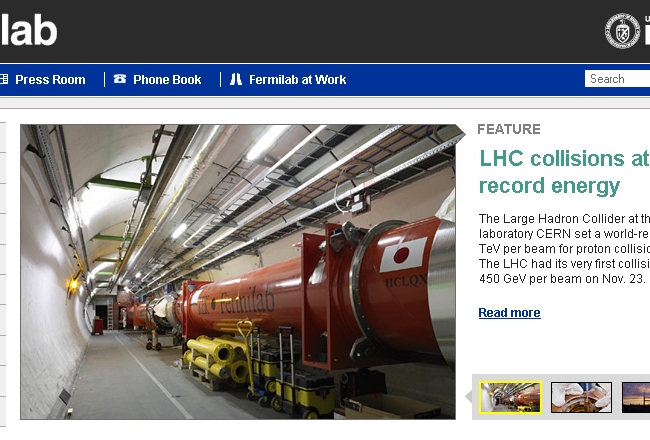It thus looks like the Tevatron is unwilling to let the spotlight be stolen by the imminent runs at 7 TeV by the Large Hadron Collider. Nevertheless, with not little fair play, the front page of the Fermilab web site still features a story on the 1.18 TeV world record of the LHC proton beams, as you can see from the snapshot below. Maybe the fact that the picture shows a magnet with a large "Fermilab" banner on top helped the decision... If you can't beat them, join them, seems to be the hidden message.

At CERN, the operations of the LHC have restarted after a three-month break, with the plan of producing enough proton-proton collisions to reach significantly further in discovery territory, where the Tevatron will never manage to get despite the excellent performances. 7 TeV collision energy is not as much as the design 14 TeV energy, but it is still 3.5 times higher than what the Tevatron can deliver, and this means a lot in terms of discovery potential.
The flux of particles crossing the collision region in a collider in a given instant is called "instantaneous luminosity". It is an enormous number if written in units (inverse square centimeters times inverse seconds) which is an area that protons have little to do with. Better than square centimeters, we should use the "barn", a subatomic unit that is a characteristic area for electromagnetic processes at low energy. The name barn comes from the phrase "as big as a barn", and indeed for a subatomic particle a barn is a large area: it is a square of a trillionth of a centimeter on each side. Atomic nuclei -huge beasts in the subatomic realm- have similar dimensions. In units per barn per second, the Tevatron record is written 3.76E8, or a third of a billion. A more manageable number.
What we can do with instantaneous luminosity, to figure out what it means to have it so high in the center of CDF and DZERO, is to multiply it by the "cross section" of known particle reactions occurring when protons and antiprotons interact. Cross sections are written in area units, so when you multiply instantaneous luminosity by cross section you get a rate in units per second: a collision rate. Let me list a few of them below.
- A generic scattering of a proton and an anti-proton has a typical cross section of 0.08 barns: this means that, at the luminosity of 3.76E8 inverse barns per second, there are about 30 million such collisions. The experiments have trigger systems that sift through these 30 million every second, selecting the most promising hundred or so for data storage. The other 29,999,900 ar dumped!
- The creation of a W boson is much less frequent: its cross section is of about 20 nanobarns, (one nano is a billionth, in scientific lingo). This means that the Tevatron produces about 4E8 x 20E-9 = 8, eight W boson inside CDF or DZERO every second. They are rare, but not overly so at this high luminosity!
- The creation of a top-quark pair is still more than a thousand times more rare than W production: its cross section is of 7 picobarns (one picobarn is a trillionth of a barn). We thus learn that every second a total of 4E8 x 7E-12= 2.8E-3 top pairs are produced. Or better, one pair every six minutes, or ten per hour. Not many, but compare to the early days of Run 0 (1987-88): then the instantaneous luminosity was 100 times smaller, and the top cross section 30% smaller too (the Tevatron then ran at 900 GeV per beam, or 1.8 TeV center-of-mass energy): this meant producing only a couple top quark pairs per day; more realistically, since instantaneous luminosity decreases from the start of a run to the end, and a run lasts less than a day, probably one top pair per day is a better approximation. No wonder we ended up selecting just one clean candidate... It was not enough for discovery of course, but it was more than enough to stir a huge controversy, one which was discussed at length here in the past.
- And how many Higgs bosons ? Well, that depends, on the Higgs boson mass of course. If the Higgs has a mass of 120 GeV, say, then its total cross section is slightly less than one picobarn. This means one Higgs boson per hour!
If the Tevatron is producing one Higgs per hour, how come they are not showing up ? Well, it is hard to detect them! Only a fraction of these produced events can be selected and studied, because when the Higgs decays in ways that are not easy to measure and discern from backgrounds, there is no chance. See, we are fighting with the huge cross sections of the more frequent processes listed above, which all interfere with the task of isolating Higgs events.
The Higgs might be out of reach of the Tevatron, but they are certainly doing their best to surprise us! Kudos to the Tevatron!



Comments